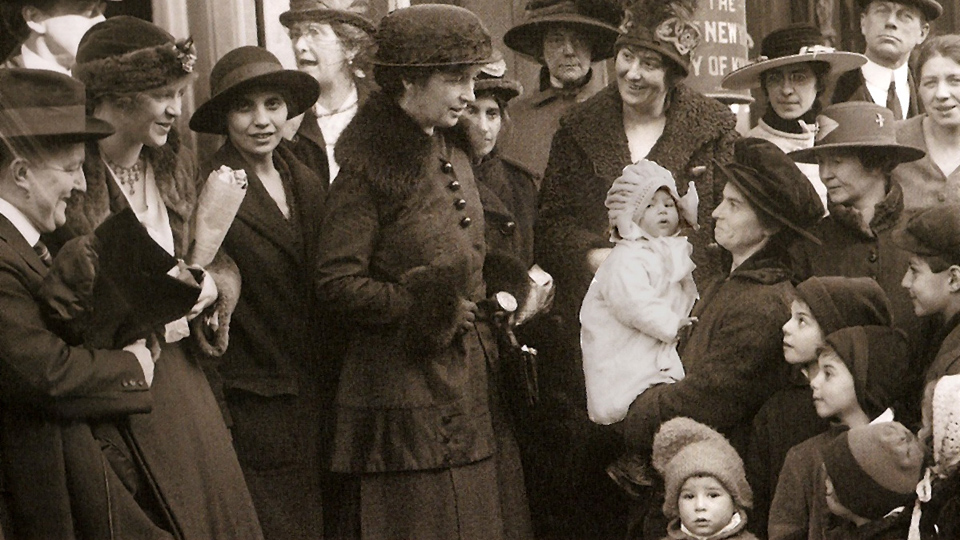
One hundred years ago this week, on October 16, 1916, pioneer of the American birth control movement Margaret Sanger opened the nation’s first birth control clinic along with her sister Ethyl Byrne, who was a registered nurse, and an interpreter named Fania Mindell. Sanger chose the Brownsville neighborhood of Brooklyn, N.Y., for her first clinic because she knew from her conversations with residents that the neighborhood would welcome it.
The Brownsville Clinic was modeled after the birth control clinics that Sanger observed in Holland in 1915. Each woman who visited the clinic received Sanger’s pamphlet What Every Girl Should Know, a short lecture on the female reproductive system, and instructions on the use of various contraceptives for a charge of ten cents.
A new day was dawning in America, according to Sanger: “The poor, century-behind-the-times public officials of this country might as well forget their moss-grown statutes and accept birth control as an established fact,” she was quoted in the New York Call. “My new national plan makes it as inevitable as night and day.”
The clinic operated secretly, relying on word of mouth and covert advertising to get women in the door. It served more than 100 women on its first day, and reached approximately 400 in the ten days that it was operational. On October 26th an undercover policewoman and vice-squad officers raided the clinic and arrested Sanger, Byrne and Mindell.
Sanger was released from jail the following morning. She reopened the clinic on November 14, but was arrested again, this time charged with maintaining a public nuisance. She opened it once more on November 16, but police forced the landlord to evict Sanger and her staff, and the clinic closed its doors a final time.
The trial began on January 29, 1917. Sanger was convicted and offered a suspended sentence if she promised not to repeat the offense, but she refused to make that promise. As a result, she was given a choice of a fine or jail sentence. She chose to spend 30 days in the Queens County Penitentiary, and finished her sentence without incident.
Sanger appealed her conviction, and her case journeyed through the courts for a year until the New York Court of Appeals sustained her conviction in January 1918. Despite ruling against her, Judge Frederick Crane’s decision included a more liberal interpretation of New York State law, enabling physicians for the first time to legally prescribe contraception for general health reasons rather than exclusively for venereal disease.
The ruling, brought about by Sanger’s bravery and willingness to break laws, became the bedrock for doctor-staffed birth control clinics, an integral part of the birth control movement’s goal to afford all women, regardless of income, access to effective contraceptives.
In 1921 Sanger founded the American Birth Control League, whose mission was to provide education on the prevention of pregnancy. She served as its president until 1928. The organization would later be known as the National Birth Control League, and eventually the Planned Parenthood Federation of America.
In the light of today’s perspective
Despite her historic accomplishments, human consciousness belonging to its place and time, Sanger can be viewed from today’s perspective in an unflattering light. She increasingly appealed to the societal need to limit births by those least able to afford children. The affluent and educated already limited their childbearing, while the poor and ignorant lacked access to contraception and information about birth-control.
Here she found an area of overlap with eugenicists, who included in their ranks many leading intellectuals. She believed that they both sought to “assist the race toward the elimination of the unfit.” Eugenicists believed that a woman’s first duty is to the state, while Sanger argued for woman’s duty to herself, which would contribute to the aims of the state. Sanger advocated negative eugenics, aiming to improve human hereditary traits through social intervention by reducing the reproduction of those considered unfit.
In “The Morality of Birth Control,” a 1921 speech, she divided society into three groups: the “educated and informed” class that regulated the size of their families, the “intelligent and responsible” who desired to control their families in spite of lacking the means or the knowledge, and the “irresponsible and reckless people” whose religious scruples “prevent their exercising control over their numbers.” Sanger concludes, “There is no doubt in the minds of all thinking people that the procreation of this group should be stopped.”
Sanger supported an exclusionary immigration policy, free access to birth control methods, and full family planning autonomy for the able-minded, as well as compulsory segregation or sterilization for the “profoundly retarded.” Others of her contemporaries, such as eugenicist William Robinson, advocated euthanasia for the unfit, and some historians trace the origins of the Nazis’ theories of race and population to the American eugenics movement. But Sanger opposed these extreme measures. She believed the responsibility for birth control should remain in the hands of able-minded individual parents rather than the state, and that self-determining motherhood was the only unshakable foundation for racial betterment.
During her later years, Sanger published numerous books, including My Fight for Birth Control and Margaret Sanger: An Autobiography. Not only did Sanger live to see the realization of her “magic pill” for birth control, but four years later, at the age of 81, Sanger witnessed the undoing of the Comstock laws regulating sexual expression and contraception. In the 1965 Supreme Court case Griswold v. Connecticut, the court ruled that the private use of contraceptives was a constitutional right. When Sanger passed away a year later, after more than half a century of fighting for the right of women to control their own fertility, she died knowing she had won the battle.
She died 50 years ago, on September 6, 1966, at a Tuscon, Ariz., nursing home.
Today we are still seeing a war on women in America, attempts to turn back the right to reproductive choice, and broad attacks on Planned Parenthood.
Sources: The Margaret Sanger Papers Project , Wikipedia and U.S. history.com.












Comments